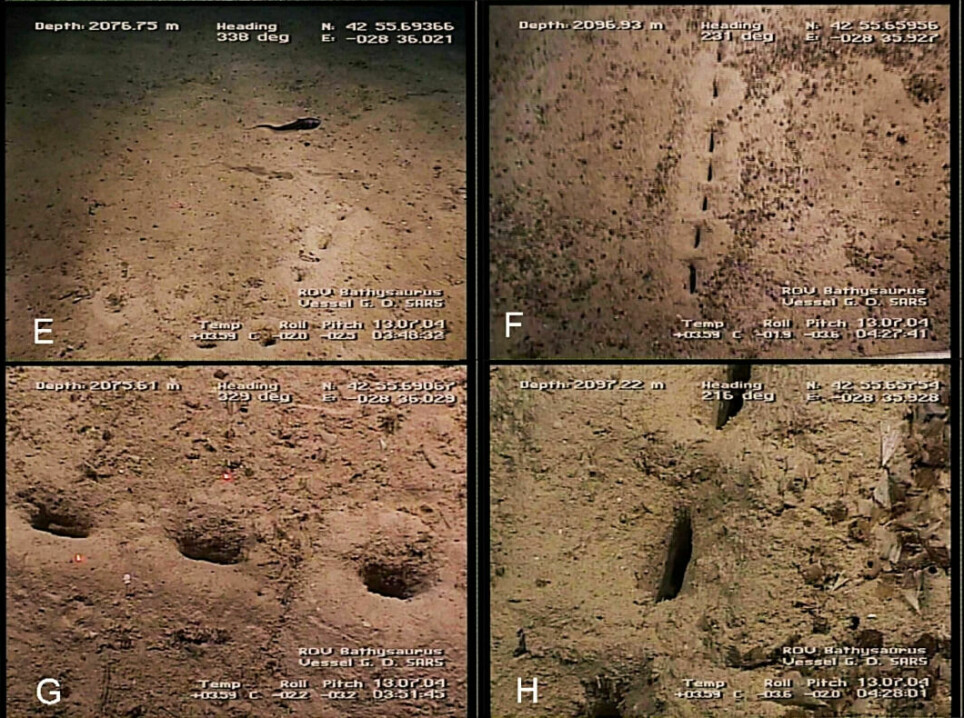
What are these holes at the bottom of the Atlantic Ocean?
Marine scientists discovered them by accident.
It's July 13, 2004.
The crew on board the Norwegian research ship G.O. Sars has sent an unmanned remotely operated underwater vehicle – an ROV – with a camera down to the seabed in the middle of the Atlantic Ocean, somewhere north of the Azores archipelago.
“Completely unexpectedly, these tracks suddenly appeared on the screen below from a depth of around 2,000 metres,” Odd Aksel Bergstad tells sciencenorway.no.
Bergstad led the expedition at the time. He is now retired from his job as a researcher at the Norwegian Institute of Marine Research.
Nevertheless, Bergstad has, together with the American marine scientist Michael Vecchione, published a report summarising what we know about the holes.
The reality is that we still know very little.
The two researchers hope to ignite the curiosity of other researchers who might take a closer look at the discovery.
No conclusion
“There has been a lot of discussion between researchers about what this could be,” Bergstad says. “But we have not come to any definite conclusion.”
He himself is almost convinced that there is no physical explanation behind the holes.
“Most likely this is a track left by something alive,” he says.
Sediments, which have been thrown up next to several of the holes, can point in this direction.

An unknown animal
The marine scientist does not rule out that we are talking about a hitherto unknown animal.
“There are still a number of undescribed animals and other organisms in the deep sea,” Bergstad says. “Much is still poorly explained by science. We are also talking about huge ocean areas.”
The tracks you see pictures of have been set in soft seabed. This means that they are not fossil traces. The traces must be of an organism that still lives in the sea, Odd Aksel Bergstad believes.

Discovered the dinosaurs
Around 200 years ago, researchers began to take an interest in tracks found in solidified rock on land.
The tracks were often regular prints one after the other. They could look like footprints. Some were gigantic. Others were much smaller.
This is how researchers at the beginning of the 19th century came on the trail of both the dinosaurs and many other, then unknown, smaller animals that had lived a long time ago.
Only just beginning to explore the seabed
The exploration of the biological diversity on the vast seabed on Earth has only just begun.
Many new things can be found.
That traces of animals or other organisms have been found deep in the sea, is not new. Life that is initially unidentified.
The German word "Lebensspuren" – traces of life in English – was first used by German researchers in the 1970s, when the very first photographs from the deep sea showed traces of life, but that we didn’t know what it was.
Today, "Lebensspuren" is used by researchers as a collective term for traces, tracks and imprints of what we can assume are living organisms down in the sea.
———
Translated by Alette Bjordal Gjellesvik.
Read the Norwegian version of this article on forskning.no
Reference:
Vecchione, M. and Bergstad, O.A. Numerous Sublinear Sets of Holes in Sediment on the Northern Mid-Atlantic Ridge Point to Knowledge Gaps in Understanding Mid-Ocean Ridge Ecosystems, Frontiers in Marine Science, vol. 9, 2022. DOI: 10.3389/fmars.2022.812915
------





































